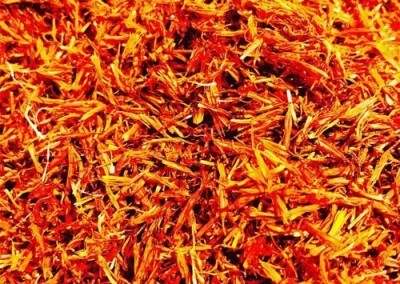What is CLA Safflower Oil?
CLA Safflower Oil is a weight loss aid released in early 2016. Whereas its manufacturer created it for a sole purpose of helping people shed pounds easier – the supplement’s main ingredient has an area of action far wider and much more complex than that. The oil improves metabolism, breaks down the already existing fat tissues while preventing new ones from occurring, and sustains the formation of lean muscles. CLA Safflower Oil is not approved by the U.S. Food and Drug Administration at the present moment. However, it is produced in an FDA registered laboratory, an aspect which makes it reliable and trust-worthy for people to use it.
CLA Safflower Oil is not an over-the-counter drug, so you do not need a medical prescription as to buy it. Since it can lead to side effects one might not be aware of, always consult with a doctor before considering it a safe option.
Ingredients
 Each capsule contains a blend of 80% Safflower Oil, and a mix of ingredients that make up for the remaining 20%, and which were integrated as to make CLA Safflower Oil an excellent product. What exactly this mix is made of we have yet to find out.
Each capsule contains a blend of 80% Safflower Oil, and a mix of ingredients that make up for the remaining 20%, and which were integrated as to make CLA Safflower Oil an excellent product. What exactly this mix is made of we have yet to find out.
The only piece of information provided to possible customers in regards to this aspect is available in the Terms section found on the supplement’s website which states the ingredients were used raw, therefore fresh. However, the secondary compounds are rapidly left aside, as the manufacturer prefers putting emphasis on the oil instead. This might not constitute an issue for all buyers, except for those who follow a vegetarian diet and want to avoid constituents of animal origin. Even so, the detail which excludes CLA Safflower Oil from their list is the capsules’ shells, made of gelatin, most probably coming from a non-vegetarian source.
It is likely that the additional blend was incorporated to enhance the main ingredient’s absorption, but a full list would be more than welcomed, especially as we are talking about health, a domain which concerns us directly.
Safflower Oil
Safflower is an annual plant native to the arid regions of the Middle East where the largest quantities of flowers are produced. Europe and the United States have manifested an increasing interest, which means the overall production is bound to increase in the following years. The plant has a millenary history, with the first pieces of information dating back to the Egyptian pharaohs. The safflower was used for an entirely different purpose back then, being more significant for its beauty-enhancing properties, rather than its health-related ones. In brief, the plant was known as a natural dye, thanks to its bright yellow, orange, and red flowers.
 People have extensively employed the flowers in coloring textiles, and have even used them as a saffron substitute in various dishes. This has happened without much success, though, as safflower is rather poor regarding flavor, and its coloring properties are not that potent either.
People have extensively employed the flowers in coloring textiles, and have even used them as a saffron substitute in various dishes. This has happened without much success, though, as safflower is rather poor regarding flavor, and its coloring properties are not that potent either.
The mid-20 century comes with a shift in perception, as people realize there is a far more valuable part they can take advantage of – the seeds. Whereas present in the Eastern industry for many years before reaching success on the western lands as well, mass production debuted later on. This might be one of the reasons why the safflower seed oil lacked the well-deserved popularity, although it could have served humanity in ways other oils could have not. Another reason for its relatively weak production is the climate. Safflower thrives in drylands with medium to high temperatures, which allows for the flowers to produce the seeds annually, in early September. Each flower has anywhere between 15 and 30 seeds, with each seed containing up to 45% oil.
Researchers distinguish between two broad types of oil obtained from the safflower, one richer in monounsaturated fatty acids (oleic acid), and one with higher concentrations of polyunsaturated fatty acids (linoleic acid). They both are seed-derived types, with significant levels of omega-9 fatty acids, acknowledged for their health-related benefits. Studies have shown that daily intake of seed-derived safflower oil improves the immune system’s function and lowers LDL or “bad” cholesterol levels. There is also a third type of oil, a flower-derived one, less popular, and with a higher percentage of omega-6 fatty acids. Researchers have linked them with an increased incidence of stroke and diabetes due to their pro-inflammatory capacities.
Safflower oil is possibly effective in patients with estrogen-related osteoporosis, breathing problems, tumors, and might provide relief for those with constipation or menstrual disorders. Women have used safflower oil throughout history as a means to cause an abortion. For this reason, pregnant women or those who try to conceive should avoid both the oil and products containing it.[1][2]
Conjugated Linoleic Acid
Conjugated linoleic acid is the umbrella term for a group of isomers of the linoleic acid. It is mainly found in the meat and dairy products coming from grass-fed ruminants such as goats, cattle, sheep or yaks. However, some experts have recently stated that the richest source of CLA is not an animal-based product, as it was believed until then, but a plant: the safflower. Researchers have discovered 28 such isomers up to this date.
The conjugated linoleic acid is regarded as both a trans fatty acid, and a cis one, with the first being an unsaturated type, and the second having several benefits on one’s health. CLA stands out among all other trans fats thanks to its capability to create linkages in a conjugated system, an aspect which makes it less harmful. More commonly known in the bodybuilding industry nowadays, CLA’s beginnings in the world of medicine and science were much more different. Researchers have shown interest towards it after a 1979 study conducted on mice suffering from cancer. The process led to the conclusion that repeated intake of CLA inhibited the activity of cancer-inducing genes, and alleviated some of the disease’s symptoms. However, results of later studies were inconsistent. Thus, an association between this type of fatty acid and a decreased cancer incidence remains unclear until further research projects are conducted.[3]
How Does it Work?
CLA has a rather precise manner of action: upon consumption, it interacts with a group of molecular signaling receptors known as PPAR. These tiny agents are involved in various inner processes such as cell development and metabolism. Also, PPARs play a major role in the carcinogenesis of higher organisms and might reduce triglyceride levels, usually associated with higher risks of cardiovascular disease. All three types of peroxisome proliferator-activated receptors (alpha, gamma, and delta) are found in the adipose tissue, to a smaller or larger extent. General cell activity, unless disturbed, maintains the cell regulation process in the normal range. Still, due to negative emotions and reactions, as well as an improper lifestyle, the body can be easily affected, something which could trigger in turn an entire array of diseases. Fortunately, a 1994 study threw light on the effect PPAR gamma might have in patients who have type II diabetes or inflammation. The researchers conducting it have noticed that, by sustaining lipid-laden adipocyte formation, molecule modulation had a positive impact on fat cell differentiation.[4][5]
Research on PPAR has yet to reach a peak. Not much was known about these molecules until recently, but the information scientists continue providing us within this regard remains impressive, to say the least. The development of diabetes, obesity, cardiovascular disease or cancer seems to be strongly related to a malfunction of the enzymatic pathways in adipose tissues. Regulating them signifies reclaiming a good health status.
The conjugated linoleic acid is believed to do that. Various studies which involved obese patients have shown that supplementation with CLA led to a reduction of body mass index and adipose mass. One research project conducted on rodents has indicated an increase in insulin sensitivity after PPAR gamma was activated.[6]
Usage
CLA is used in treatments for obesity and high blood pressure. It might work better in individuals who are obese and show signs of hypertension. Still, this aspect remains uncertain in the absence of clinical trials involving people with high blood pressure but a healthy BMI.
Obesity
Evidence suggests a decreased fat mass in individuals who have ingested CLA on a daily basis for as long as a study took place. However, experts have stated that the general body weight registered minor changes, with insignificant shifts in the BMI. This led them to the conclusion that CLA might be effective, but not potent enough as to help one shed pounds when used alone. Another aspect to consider is that the fatty acids had little to no interaction with the lean mass. This might have happened precisely because the molecules present in their chemical structure can only bind to PPARs, thus having an impact on the activity of fat cells only.
Diabetes
Omega-type acids are widely known for being the healthiest of all polyunsaturated fatty acids. Whereas there are pieces of information on how they can lower blood sugar levels, if administrated before or after a meal, what we know up to this date is neither sufficient nor clear enough as to reach a conclusion. However, researchers have observed a decreased sensitivity to insulin in certain clinic trials, which means CLA might actually work, provided the dosage is appropriate (by every patient’s need).
High Blood Pressure
A combination of CLA and ramipril has been used in treating obese individuals suffering from hypertension for a while now. It is not known if the conjugated linoleic acid affects the blood pressure and blood flow when used separately, but researchers have demonstrated that, when taken together, it enhances ramipril’s action and makes it more efficient.
Metabolism
CLA interacts with certain molecules in our bodies responsible, to some extent, for the metabolic pathways. How fast we burn fat, and how well the body absorbs nutrients is strongly related to the proper functioning of this process. To what degree it does that remains to be seen. Present-day researchers have mixed opinions, with some leaning towards possible effectiveness.
Regarding statistics, the numbers do not speak for themselves. The conjugated linoleic acid, whereas healthier than many others, does not enjoy enough studies as to assert, once and for all, that it can indeed deliver on its promises. However, there is a long way to go, and, with a bit more attention coming from the scientific and medical systems, CLA might succeed where others have failed.
CLA Safflower Oil – Trustworthy or Not?
CLA Safflower Oil is a newly-released dietary supplement whose formula is mainly based on a rather unpopular vegetable oil, the safflower one. The studies concluded until now show contradictory results, and not even the participants to the respective research projects seemed very satisfied by it. However, this does not change the fact that, for the most part, the safflower oil had a positive effect on their health status, one way or the other.
As in the case of any other supplement, or drug for that matter, CLA Safflower Oil might work better in certain individuals. It is good to take into account that the manufacturer has designed it for obese persons, or people who want to lose weight easier than through intense exercising or dieting. Still, how well the body accommodates to it depends on the type of metabolism one has (it was demonstrated that there are several metabolic models).
The producer claims CLA Safflower Oil can help you burn fat and increase muscle mass, whether it is used by itself or combined with sport and a healthy diet. What might make it more reliable than other products containing safflower oil is its formula? As stated in a previous section, the supplement is a blend of safflower oil and other several ingredients that might influence the way one’s body absorbs it. The complete list of ingredients could also be the reason behind the different mechanisms of action of CLA, on the one hand, and CLA Safflower Oil’s overall formula, on the other.
Want to Know More about the CLA Safflower Weight Loss Supplement?
How does CLA Safflower Oil work?
CLA Safflower Oil contains certain compounds which, when released into the bloodstream, trigger various molecular reactions. Because specialists regard the oil as being a healthy one, it is safe to assume that our bodies can only benefit from its usage. Here are the ways in which CLA Safflower Oil works to provide us with maximum benefits in the shortest period:
 It stimulates the fat burning process: CLA Safflower Oil activates the Cyclic adenosine monophosphate, an ATP(adenosine triphosphate) derivate with an essential role in cell signaling and communication. Cyclic AMP’s activity is linked to that of glucagon and adrenaline, two hormones that could influence the process of lipid metabolism if abnormal levels are registered. When everything is in the normal range, cAMP sustains the lipolysis process which encourages the use of fats instead of carbohydrates as a primary energy source.
It stimulates the fat burning process: CLA Safflower Oil activates the Cyclic adenosine monophosphate, an ATP(adenosine triphosphate) derivate with an essential role in cell signaling and communication. Cyclic AMP’s activity is linked to that of glucagon and adrenaline, two hormones that could influence the process of lipid metabolism if abnormal levels are registered. When everything is in the normal range, cAMP sustains the lipolysis process which encourages the use of fats instead of carbohydrates as a primary energy source.
- It interacts with individual molecules responsible for the fat loss process: by being 100% natural, CLA Safflower Oil is quickly released into the bloodstream so the body can use it as fast as possible. Studies show that CLA, the supplement’s key ingredient, interacts with a particular group of molecules called PPAR that are found in the adipose tissue. By replacing the already-existing body fat storage with strong acids, one can stimulate the breakdown of fat tissues.
- It prevents new fat from forming by improving metabolism: “boost” might not be the word to use in this situation, but CLA Safflower Oil can increase the metabolic rate, and help you maintain a slender figure for longer. Whereas its capability to improve muscle mass is questionable, no one can argue that even the smallest result is still better than nothing.
By containing Omega-type fatty acids, CLA Safflower Oil might also suppress appetite, and impede you from eating too much, and at impropriate hours. Furthermore, by containing a rather large quantity of pure safflower oil, the supplement might be more efficient than other similar products. Therefore, users of safflower oil-based supplements with modest concentrations might successfully try this one.
Benefits and Side Effects
The prerequisite for a supplement to provide the desired results is for it to contain high-quality ingredients, and in sufficient doses for the product to work. This condition could be met when it comes to CLA Safflower Oil, given its considerable conjugated linoleic acid content. Regarding the health benefits, CLA Safflower Oil can:
- Help you burn fat easier
- Increase the metabolic rate
- Improve energy levels
- Sustain lean mass formation
- Preserve the already existing muscle mass
- Prevent new fat from forming
- Make you feel full for longer
- Decrease your appetite
- Increase serotonin levels
There is little to say when it comes to potential side effects. Safflower oil is regarded as healthy. Specialists recommend it for most people, and not only for those affected by obesity. The average dose is likely safe for everyone, except for the individuals with an underlying medical condition, and who might suffer from adverse effects. Also, pregnant women should avoid it, as it can cause miscarriage. A small number of people suffering from kidney diseases have reported side effects. Safflower oil might have a negative influence in patients with diabetes, although experts should conduct more studies in this regard. There is evidence which suggests CLA might interfere with blood-clotting drugs.
Usage and Dosage
Any person over the age of 18 can use CLA Safflower Oil, provided he or she has consulted a doctor beforehand and is in good health. The dosage, as stated on the product’s website, is one SoftGel capsule per day, for as long as the doctor advises. Given that the average dose used in obese patients is of 1.8 to 7 grams per day, and we do not know yet how much safflower oil each capsule contains, the supplement might not have the same weight loss benefits. CLA Safflower Oil can be taken at any time of the day, but a certain hour should be preferred as to make sure the release of constituents is constant.
Conclusion

All in all, CLA Safflower Oil is an excellent weight loss product as long as you do not expect immediate or drastic results. Mainly made from vegetarian ingredients (except for the gelatin shells, and possibly some secondary components), of which the safflower oil shines the brightest, the supplement can be a real help. If you have experienced weight loss improvements with other oils before, then you might want to tick the safflower one off your list as well. CLA Safflower Oil might just be what you have been looking for all this time.
References













